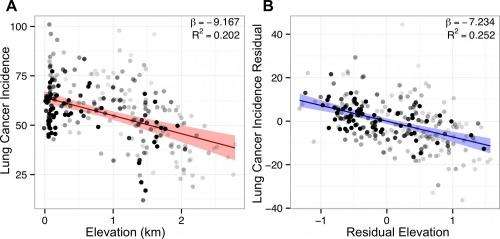In the left hand panel, lung cancer incidence is plotted against elevation for western US counties. Darker counties have higher populations and thus lower observational errors. The right hand panel shows the association when accounting for additional factors, such as smoking and education. Credit: Simeonov and Himmelstein
The ancient physician/alchemist, Paracelsus, said: "The dose makes the poison." According to a new study published in PeerJ, even oxygen may fall prey to the above adage. While essential to human life, aspects of oxygen metabolism may promote cancer. Capitalizing on the inverse relationship of oxygen concentration with elevation, researchers found lower rates of lung cancer at higher elevations, a trend that did not extend to non-respiratory cancers, suggesting that carcinogen exposure occurs via inhalation.
In the United States, lung cancer is responsible for 27% of all cancer deaths, claiming an estimated 160,000 lives per year [1]. While smoking is linked to as many as 90% of lung cancer cases, this new study suggests that atmospheric oxygen may play a role in lung carcinogenesis.
Oxygen is highly reactive and even when it is carefully and quickly consumed by our cells, it results in reactive oxygen species (ROS) which can lead to cellular damage and mutation. While oxygen composes 21% of the overall atmosphere, lower pressure at higher elevations results in less inhaled oxygen - an effect which notoriously frustrates athletes at high altitudes. For example, across United States counties, elevation differences account for a 34.9% decrease in oxygen from Imperial County, California (-11 m) to San Juan County, Colorado (3473 m).
To investigate whether inhaled oxygen could be a human carcinogen, two researchers compared cancer incidence rates across counties of the elevation-varying Western US. They found that as county elevation increased, lung cancer incidence decreased. The effect was dramatic with incidence decreasing by 7.23 cases per 100,000 individuals for every 1,000 meter (3,281 feet) rise in elevation, equating to approximately 13% of the mean lung cancer incidence of 56.8 cases per 100,000 individuals. A variety of statistical techniques attested that the association was not due to chance.
The observed association does not prove that oxygen causes lung cancer. The study looked at groups of people rather than individuals and many variables in addition to oxygen levels are correlated with elevation. Accordingly the researchers performed a thorough analysis to investigate confounding potentials. Their model accounted for important risk and demographic variables, such as smoking prevalence and education. The association was consistent across population subgroups, states, and models that included a range of additional factors.
The researchers also evaluated breast, colorectal, and prostate cancer: the remaining three most common cancers in the United States. Elevation's association with these non-respiratory cancers was either weak or absent, supporting the hypothesis of an inhaled risk factor. Furthermore, environmental correlates of elevation, such as sun exposure and fine particulate matter (a measure of pollution), produced vastly inferior predictions of lung cancer incidence compared to elevation itself.
Two past epidemiological reports, looking at elevation as a confounder, proposed that elevation-dependent oxygen variation was responsible for lower cancer mortality at high elevation [2, 3]. Unlike the two previous studies, the current study was specifically designed to assess the effect of elevation and benefited from a recent proliferation of high-quality county-level data. In total, the study relied on over 30 variables with sufficient coverage and precision to enable the inclusion of ~250 Western US counties. Using high resolution census data, the researchers calculated elevation values that reflected population dispersion within each county, thereby more accurately estimating the atmospheric exposure of each county's populace. All resources were public, underscoring the importance of open data for future scientific discovery.
The research was published today in the peer-reviewed open access journal PeerJ.
The authors hope additional researchers will focus their efforts on oxygen's role in human carcinogenesis. Analysis of diverse regions and individual-level datasets would contribute further epidemiological evidence. Ultimately, completely-controlled, experimental investigation using models of carcinogenesis will be critical to our understanding of the phenomenon.
If future analyses confirm oxygen-driven tumorigenesis, the medical implications could be large. For example, as the authors explain, "were the entire United States situated at the elevation of San Juan County, CO (3473 m), we estimate 65,496 fewer new lung cancer cases would arise per year." While the authors do not expect or recommend individuals to relocate based on this finding, identifying a universal and major risk factor could provide new insights into lung cancer etiology. From these insights, better treatments and preventative measures may arise.
More information: [1] Siegel R, Ma J, Zou Z, Jemal A (2014) Cancer statistics, 2014. CA: A Cancer Journal for Clinicians. DOI: 10.3322/caac.21208
[2] Weinberg CR, Brown KG, Hoel DG (1987) Altitude, radiation, and mortality from cancer and heart disease. Radiation Research. DOI: 10.2307/3577265
[3] Van Pelt WR (2003) Epidemiological associations among lung cancer, radon exposure and elevation above sea level. Health Physics. pubmed:13678279
Journal information: PeerJ
Provided by PeerJ



















